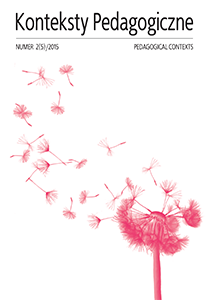Abstract
Today, many people use in their professional career their voice as a tool of work. These are teachers, lecturers, actors, politicians, TV presenters, speakers. This group uses mainly voice in speech. However, singers, actors and finally priests also use their voice for singing. Between speech and singing there is no essential differences, because they are based on the same physiological process-es. However, there are some quantitative differences (deeper breathing, greater volume, etc.). We should remember that singers use various vocal techniques by which they obtain the desired voice quality. Therefore, it is reasonable to use elements, such as classical singing, in the training of the spoken voice. This can be not only a kind of improvement of voice emission, but also become a tool for therapy or rehabilitation of one’s voice.
References
Binkuńska E., Higiena i emisja głosu mówionego, Bydgoszcz 2012.
Brégy W., Elementy techniki wokalnej, Kraków 1974.
Cygańska J., Zarys metodyki nauczania śpiewu solowego, Poznań 1963.
http://mamzdrowie.pl/niezwykla-terapia-spiewem/ [dostęp: 02.07.2015].
http://www.biomedical.pl/aktualnosci/terapia-spiewem-pomaga-pacjentom-po-uda-rze-mozgu-4500.html [dostęp: 02.07.2015].
Klajman S., Tworzenie głosu, [w:] Higiena głosu śpiewaczego, red. J. Krassowski, Gdańsk 1990.
Mielnik M.I., Badania nad zastosowaniem elementów śpiewu klasycznego w rehabilitacji chorych z zaburzeniami głosu, Kraków 2011.
Prygoń S., Interpretacja. Mówię, czytam, wygłaszam, Warszawa 2007.
Romaniszyn B., Z zagadnień sztuki i pedagogiki wokalnej,Kraków 1957.
Sielużycki C., Wybrane wiadomości z anatomii i fizjologii do użytku nauczycieli i uczniów szkół muzycznych, cz. 3: Zarys budowy i czynności narządu głosu (foniatria), Warszawa 1963.
Sobierajska H., Uczymy się śpiewać, Warszawa 1972.
Szkiełkowska A., Kazanecka E., Emisja głosu, wskazówki metodyczne, Warszawa 2011. Toczyska B., Sarabanda w chaszczach (ćwiczenia samogłosek), Gdańsk 1997.
In accordance with the recommendation of the Ministry of Science and Higher Education, which aims to counteract the practice of “ghostwriting” and “guest authorship,” all authors submitting their text for publication should attach an author’s statement which declares the contribution of each of the authors to the article. The printed and signed statement should be delivered by mail or other means to editor-in-chief Joanna Skibska or sent in the form of a scan to the following e-mail address: redakcja@kontekstypedagogczne.pl. The authors will not receive remuneration for publishing their papers. The editors reserve the right to make minor editorial changes to the articles which will not affect the substance of the article. We encourage all authors to prepare their articles in accordance with the guidelines for manuscript preparation. Download pdf file.
Authors transfer all copyrights and grant the journal the right of first publication with the work simultaneously licensed under a Creative Commons Attribution License that allows others to share the work with acknowledgement of the work's authorship and initial publication in this journal. All authors agree to the publishing of their email addresses, affiliations and short bio statements with their articles during the submission process.

